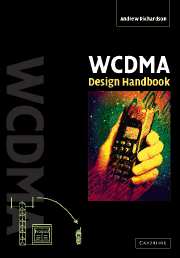Book contents
- Frontmatter
- Dedication
- Contents
- Preface
- Acknowledgements
- List of abbreviations
- 1 Introduction
- 2 WCDMA in a nutshell
- 3 Spreading codes and modulation
- 4 Physical layer
- 5 RF aspects
- 6 Chip rate processing functions
- 7 Symbol rate processing functions
- 8 Layer 2 - medium access control (MAC)
- 9 Layer 2 - RLC
- 10 PDCP and BMC protocols
- 11 Layer 3 - RRC
- 12 Measurements
- 13 NAS
- 14 Idle mode functions
- Appendix
- References
- Index
11 - Layer 3 - RRC
Published online by Cambridge University Press: 05 October 2013
- Frontmatter
- Dedication
- Contents
- Preface
- Acknowledgements
- List of abbreviations
- 1 Introduction
- 2 WCDMA in a nutshell
- 3 Spreading codes and modulation
- 4 Physical layer
- 5 RF aspects
- 6 Chip rate processing functions
- 7 Symbol rate processing functions
- 8 Layer 2 - medium access control (MAC)
- 9 Layer 2 - RLC
- 10 PDCP and BMC protocols
- 11 Layer 3 - RRC
- 12 Measurements
- 13 NAS
- 14 Idle mode functions
- Appendix
- References
- Index
Summary
Introduction
In this chapter we examine the structure and the operation of the RRC protocol. The RRC protocol is the main AS control protocol. It is responsible for the configuration and control of all of the different layers that create the radio connection between the UE and the UTRAN. It is a large and complex protocol and consequently, in this chapter, we consider only some key aspects of its operation, leaving the interested reader to consult the relevant specification [24] for a more thorough description.
We start this chapter with a review of the RRC protocol architecture before considering specific key elements of its operation.
Architecture and messages
The RRC protocol architecture is illustrated (from the perspective of the UE) in Figure 11.1. The key functions of the architecture are the dedicated control functional entity (DCFE), the paging and notification functional entity (PNFE) and the broadcast control functional entity (BCFE).
The RRC messages are passed between the UE and the UTRAN. They are used to configure and control the RRC connection between the UE and the UTRAN. The RRC messages can be loosely grouped into four categories: RRC connection management messages; RB control messages; RRC connection mobility messages and RRC measurement messages.
- Type
- Chapter
- Information
- WCDMA Design Handbook , pp. 349 - 394Publisher: Cambridge University PressPrint publication year: 2005



